Scientific publication PLoS Neglected Tropical Diseases called Chagas' new Endemic AIDS of the Americas. A team from the Baylor College of Medicine, which studies tropical diseases, believe that The spread of the life-threatening illness disease are similar to the way how HIV spread. The disease can be spread through blood transfusion and organ transplantation, ingestion of food contaminated with parasites, and from a mother to her fetus.
Found only in Latin America, where it causes more deaths than any other parasitic disease, including Malaria .Chagas disease are caused by a parasite that is transmitted to humans by the bite of insects.
 |
| Carlos Chagas, in his laboratory at the Instituto Oswaldo Cruz |
Chagas disease is named after the Brazilian physician Carlos Chagas (picture), who discovered the disease in 1909. It is caused by the parasite, the Triatomine bug or Trypanosoma cruzi, which is transmitted to animals and people by insect vectors and is found only in the Americas (mainly, in rural areas of Latin America where poverty is widespread). Chagas disease (T. cruzi infection) is also referred to as American trypanosomiasis.
Chagas disease is endemic throughout much of occurs of Latin America and so far had infected 10 million people, mostly residents of Bolivia, Mexico, Colombia and Central America. The triatomine bug thrives under poor housing conditions (for example, mud walls, thatched roofs), so in endemic countries, people living in rural areas are at greatest risk for acquiring infection. However, in the past decades it has been increasingly detected in the United States of America, Canada, many European and some Western Pacific countries. This is due mainly to population mobility between Latin America and the rest of the world. Less frequently, it is due to infection through blood transfusion, vertical transmission (from infected mother to child) or organ donation.
This has caused great alarm to many countries , This include in the United States, Chagas disease is considered one of the dangerous Neglected Parasitic Infections, Its now a group of five parasitic diseases that have been targeted by CDC for public health action.
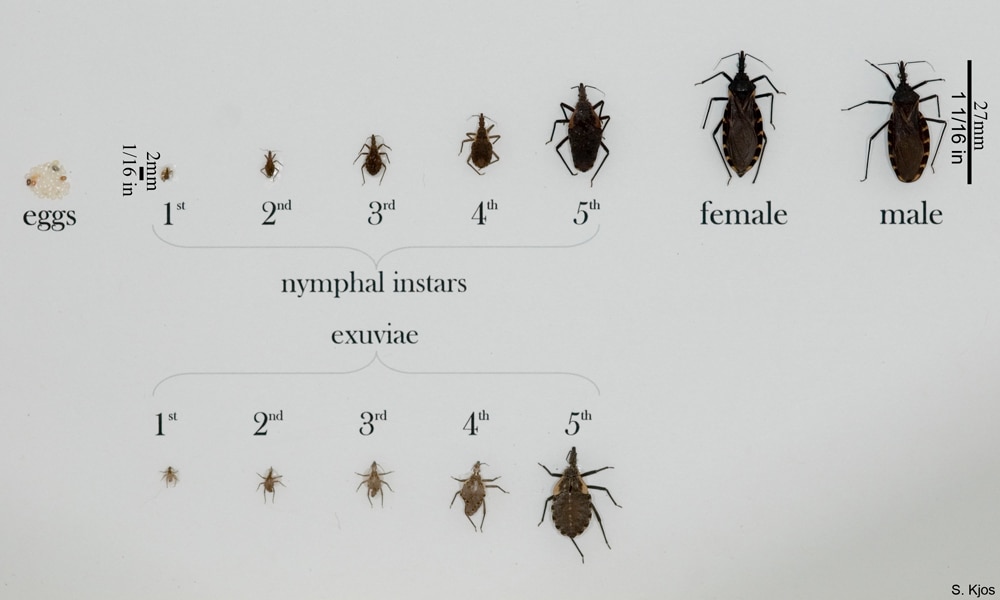 CDC estimates that more than 300,000 persons with Trypanosoma cruzi
infection live in the United States. Most people with Chagas disease in
the United States acquired their infections in endemic countries.
Although there are triatomine bugs in the U.S. , only rare vectorborne
cases of Chagas disease have been documented.
CDC estimates that more than 300,000 persons with Trypanosoma cruzi
infection live in the United States. Most people with Chagas disease in
the United States acquired their infections in endemic countries.
Although there are triatomine bugs in the U.S. , only rare vectorborne
cases of Chagas disease have been documented. Roughly a quarter of the victims heart or intestines gradually grow abnormally by the diseases, which can lead to sudden death. There is no vaccine for Chagas disease. Existing drugs are only effective at the early stage of the disease.
----------------------------------------------------------------
Various Triatomine Bugs in all Life Stages
Various triatomine bugs in all life stages, from eggs to nymphs to fully grown adults. A variety of bug species, that share similar traits, are pictured.
Signs and symptoms
Chagas disease presents itself in two phases. The initial, acute phase lasts for about two months after infection. During the acute phase, a high number of parasites circulate in the blood. In most cases, symptoms are absent or mild, but can include fever, headache, enlarged lymph glands, pallor, muscle pain, difficulty in breathing, swelling and abdominal or chest pain. In less than 50% of people bitten by a triatomine bug, characteristic first visible signs can be a skin lesion or a purplish swelling of the lids of one eye.
During the chronic phase, the parasites are hidden mainly in the heart and digestive muscle. Up to 30% of patients suffer from cardiac disorders and up to 10% suffer from digestive (typically enlargement of the oesophagus or colon), neurological or mixed alterations. In later years the infection can lead to sudden death or heart failure caused by progressive destruction of the heart muscle.
PAGE FROM THE CDC
http://www.cdc.gov/parasites/chagas/gen_info/vectors/index.html#id
------------------------------------------------------------------------------------------------
I think I found a triatomine bug. What should I do?
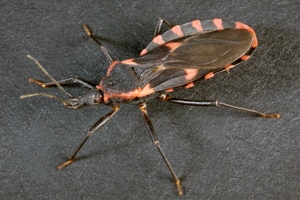
Triatoma sanguisuga Photo Courtesy: James Gathany
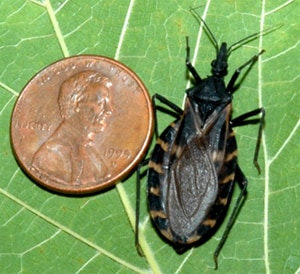
Triatoma gerstaeckeri next to a penny for scale. Photo courtesy S. Kjos.
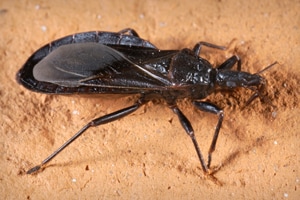
Triatoma protracta Photo Courtesy: James Gathany
Any material containing bug parts or feces should also be submitted for testing, preferably in a plastic bag or clean sealable container. Surfaces that have come into contact with the bug should be cleaned with a solution made of 1 part bleach to 9 parts water (or 7 parts ethanol to 3 parts water)
How can I tell if the bug I’ve found is a triatomine and not another kind of bug?
There are many beetles and non-triatomine reduviid bugs that resemble the triatomine bug. Two examples of non-triatomine reduviid bugs that do not feed on human blood are the wheel bug and the assassin bug. Some plant-feeding bugs, such as Coreidae, also resemble the triatomine. If you are unsure if the bug you’ve found is a triatomine, you may wish to consult with an expert, such as an entomologist, for clarification.Can I get Chagas disease from a triatomine bug?
Yes. However, the transmission of Chagas disease from a bug to a human is not easy. The parasite that causes the disease is in the bug feces. The bug generally defecates on or near a person while it is feeding on his or her blood, generally when the person is sleeping. Transmission occurs when fecal material gets rubbed into the bite wound or into a mucous membrane (for example, the eye or mouth), and the parasite enters the body.It is important to note that not all triatomine bugs are infected with the parasite that causes Chagas disease. The likelihood of getting Chagas disease from a triatomine bug in the United States is low, even if the bug is infected.
Could I be allergic to the bite of a triatomine bug?
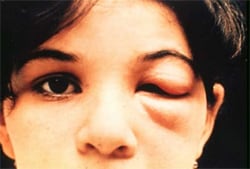
Romaña's
sign, the swelling of the child's eyelid, is a marker of acute Chagas
disease. The swelling is due to bug feces being accidentally rubbed into
the eye, or because the bite wound was on the same side of the child's
face as the swelling. Photo courtesy of WHO/TDR.
The appearance of an allergic reaction after a triatomine bite does not mean that you have been infected with the parasite Trypanosoma cruzi, the cause of Chagas disease. The mild swelling that may develop at the site of parasite inoculation (where the parasite entered the body through the skin or mucous membranes) is called a chagoma. When the parasite enters the body through the conjunctiva of the eye, the swelling around the eye is called Romaña’s sign. Chagomas, including Romaña’s sign, usually last longer than an allergic reaction and are less likely to be severely itchy.


0 comments:
Post a Comment